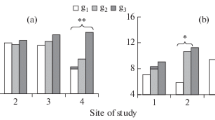Abstract
Fourteen morphometric variables of silver birch (Betula pendula Roth) leaves from two sites in the Upper Silesia province were analyzed to establish the pattern of intrapopulational and interpopulational relations. The leaves were collected from ten trees growing on a zinc–lead dump as well as from ten trees in the unpolluted area of Mirów within the same bioclimatic region. Leaf samples were collected from the trees during the vegetative seasons 1999 and 2000. The size and shape of leaves were studied using standard biometric methods. Cluster analysis indicated overall differences between the populations. Both populations differed with respect to almost all the morphometric variables (P<0.05). Most variables of the leaves, collected from single trees (or combined as a total) on the zinc–lead dump showed more variability than those from the unpolluted site. Discriminant function analysis confirmed the angle of the leaf base as the most important variable in the evaluation of interpopulational variability of leaves.





Similar content being viewed by others
References
Ackerly DD, Bazzaz FA (1995) Seedling crown orientation and interception of diffuse radiation in tropical forest gap. Ecology 76:1134–1146
Atkinson M (1990) Betula pendula and Betula pubescens. J Ecol 80:837–870
Atkinson M, Jervis A, Sangha S (1997) Discrimination between Betula pendula, Betula pubescens, and their hybrids using near-infrared reflectance spectroscopy. Can J For Res 27:1896–1900
Bojarczuk K, Karolewski P, Oleksyn J, Kieliszewska-Rokicka B, Żytkowiak R, Tjoerlker MG (2002) Effect of polluted soil and fertilisation on growth and physiology of silver birch (Betula pendula Roth) seedlings. Pol J Environ Stud 11:483–492
Boratyńska K (2002) Needle variability of Pinus mugo Turra in the West Tatra Mts. Dendrobiology 48:3–8
Castillo-Rivera M, Kobelkowsky A, Chavez AM (2000) Feeding biology of the Citharichthys spilopterus (Bothidae) in a tropical estuary of Mexico. J Appl Ichthyol 16:73–78
De Jong PC (1993) An introduction to Betula: its morphology, evolution, classification and distribution with a survey of recent work. Proceedings of the IDS Betula Symposium 2–4 October 1992. International Dendrology Society, Auckland, pp 7–18
Falińska K (1998) Plant population biology and vegetation processes. Wł. Szafer Institute of Botany/Polish Academy of Science, Kraków
Franiel I (2001) Development of Betula pendula seedlings growing on the “Silesia Steelworks” dumping grounds in Katowice. Acta Agrophys 51:51–57
Gardiner AS, Jeffers JNR (1962) Analysis of collective species Betula alba L. on the basis of leaf measurements. Silvae Genet 11:156–161
Gonzalez-Andres F, Chavez J, Montanez G, Ceresuela J-L (1999) Characterisation of woody Medicago (sect. Dendrotelis) species, on the basis of seed and seedling morphometry. Genet Res Crop Evol 46:505–519
Gratani L, Crescente MF, Petruzzi M (2000) Relationship between leaf life-span and photosynthetic activity of Quercus ilex in polluted urban areas (Rome). Environ Pollut 110:19–28
Hrynkiewicz-Sudnik J, Skrężyna J, Staszkiewicz J (1985) Wpływ zanieczyszczeń przemysłowych Wałbrzycha na wielkość i kształt wybranych gatunków drzew. Rocz Dendr 36:17–33
Iliev I (1990) Polymorphism of the leaf blade of birch (Betula pendula Roth). Priroda 4:52–54
Jensen R (1988) Assessing patterns of morphological variation of Quercus spp. in mixed-oak communities. Am Midl Nat 120:120–135
Jentys-Szaferowa J (1949) Analysis of the collective species Betula alba L. on the basis of leaf measurements. I. Aim and method of the work on the example of Betula verrucosa Ehrh. Bull Acad Sci Math Nat Ser B:175–214
Jentys-Szaferowa J (1950) Analysis of the collective species Betula alba L. on the basis on leaf measurements. II. Betula pubescens Ehrh., Betula tortuosa Ledeb., Betula carpatica Waldst. et Kit. Bull Acad Sci Math Nat Ser B:1–63
Jentys-Szaferowa J (1951) Analysis of the collective species Betula alba L. on the basis of leaf measurements. III. Betula oycoviensis Bess. and Betula obscura Kot. Determination of the basis on a single leaf. Bull Acad Sci Math Nat Ser B:1–3
Jentys-Szaferowa J (1959) Graficzna metoda porównywania kształtów roślinnych. Nauka Pol 3:79–110
Jentys-Szaferowa J (1979) Morfologia, systematyka i zmienność. In: Białobok S (ed) Brzozy (Betula L.). Nasze drzewa leśne, Tom VII. PWN, Warsaw, pp 25–64
Kabata-Pendias A, Pendias H (1999) Biogeochemia pierwiastków śladowych. PWN, Warsaw
Kik C, Van Andel J, Joenje W (1990) Life history variation in ecologically contrasting populations of Agrostis stolonifera. J Ecol 78:962–973
Kovaćić S, Śimić D (2001) Intrapopulational and interpopulational relations of Betula pendula Roth (Betulaceae) in Croatia, based on leaf morphometry. Acta Biol Crac Ser Bot 43:87–96
Kull O, Tulva I, Vapaavuori E (2003) Influence of elevated CO2 and O3 on Betula pendula Roth crown structure. Ann Bot 91:559–569
Lynn DE, Waldren S (2001) Morphological variation in populations of Ranunculus repens from the temporary Limestone Lakes (Turloughs) in the West of Ireland. Ann Bot 87:9–17
Pelham J, Gardiner A, Smith R (1988) Variation in Betula pubescens Ehrh. (Betulaceae) in Scotland: its nature and association with environmental factors. Biol J Linn Soc 96:217–234
Reyes O, Casal M, Trabaud L (1997) The influence of population, fire and time of dissemination on the germination of Betula pendula seeds. Plant Ecol 133:201–208
Sultan S (1995) Phenotypic plasticity and plant adaptation. Acta Bot Neerl 44:363–383
Sultan S (2000) Phenotypic plasticity for plant development, function and life history. Trends Plant Sci Rev 5:537–542
Tucić B, Tomić V, Avramov S, Pemac D (1998) Testing the adaptive plasticity of Iris pumila leaf traits to natural light conditions using phenotypic selection analysis. Acta Oecol 19:473–481
Urbaniak L, Karliński L, Popielarz R (2003) Variation of morphological needle characters of Scots pine (Pinus sylvestris L.) populations in different habitats. Acta Soc Bot Pol 72:37–44
Valkama J, Kozlov MV (2001) Impact of climatic factors on developmental stability of mountain birch growing in a contaminated area. J Appl Ecol 38:665–673
Acknowledgements
We would like to thank L. Franiel for his assistance in fieldwork. Prof. St Cabała and Dr. P. Skubała provided helpful comments on the manuscript and Dr P. Olejniczak corrected our English.
Author information
Authors and Affiliations
Corresponding author
Rights and permissions
About this article
Cite this article
Franiel, I., Więski, K. Leaf features of silver birch (Betula pendula Roth). Variability within and between two populations (uncontaminated vs Pb-contaminated and Zn-contaminated site). Trees 19, 81–88 (2005). https://doi.org/10.1007/s00468-004-0366-3
Received:
Accepted:
Published:
Issue Date:
DOI: https://doi.org/10.1007/s00468-004-0366-3




